
In addition to heart rate, blood pressure, respiratory rate, and temperature, pulse oximetry (PO) is considered to be the “fifth vital sign” of health status. Hemoglobin (Hb) is an essential part of the red blood cells responsible for delivery of oxygen from the lungs to the tissues. The amount of oxygen (O2) bound to Hb at any time is called oxygen saturation. Expressed as a percentage, the oxygen saturation (SpO2) is the ratio of the amount of oxygen bound to the Hb to the oxygen carrying capacity of the Hb. Pulse oximetry provides a noninvasive way to measure the SpO2, or arterial hemoglobin saturation. Pulse oximetry also detects arterial blood pulsations, and therefore also calculates and reports a patient’s heart rate. A pulse oximeter is a medICal device that measures the amount of oxygen in a patient’s arterial blood.
A typical oximetry sensor has a pair of light-emitting diodes (LEDs) facing a photodiode through a translucent part of the patient’s body, usually a fingertip or an earlobe. One LED is red, with wavelength of 660 nm; the other is infrared, with a wavelength of 940 nm. The percentage of blood oxygen is calculated based on the absorption rate from each wavelength of light after it passes through the patient’s body.
The generic structure of the pulse oximeter is shown on Figure 1. In addition to analog signal conditioning circuitry, it includes several ADCs and DACs, along with a Microcontroller and associated memory. Implementations using this discrete approach are relatively complex and costly in terms of hardware, real estate, and design time.
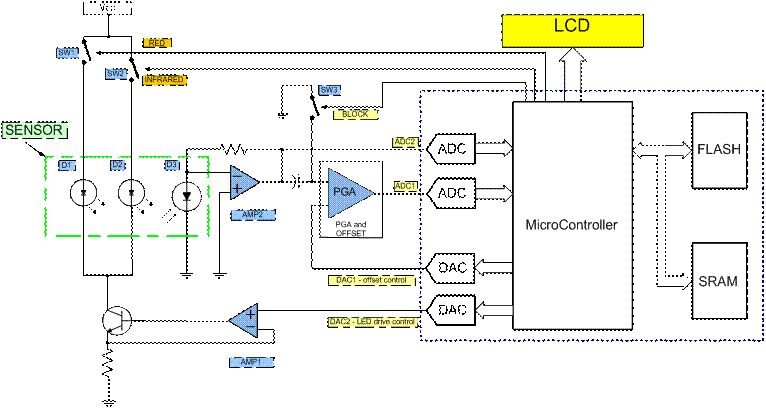
The Precision Analog Microcontroller family of products from Analog Devices includes the key analog building blocks required by a high-end oximetry design. The ADuC7024, used here, includes a high-performance, high-speed, multichannel 12-bit, 1-MSPS ADC and two DACs. These features allow recovery of the weak arterial pulsatile signals generally seen during low peripheral blood circulation.
The MicroConverter also includes a 32-bit ARM7TDMI core. Running at 41.8 MHz, it provides a very powerful computational platform. A proprietary digital signal processing algorithm, developed by ITEC Engineering, detects arterial blood pulsations, detects and rejects motion artifacts, calculates SpO2 and heart rate values, and filters and scales the real time arterial blood pulsatile waveform (plethysmogram). Still, plenty of CPU performance is left for additional functions, such as control of the graphics LCD display, generating audio pulse tones via the onboard PWM, etc.
The structure of the oximeter based on the ADuC7024 MicroConverter is shown on Figure 2:

The LEDs are powered sequentially through a MOSFET bridge (switches SW1 and SW2). The constant current sink , built with AMP1 (1/2 AD8606), is controlled by the DAC2 output of the MicroConverter.
The photodiode amplifier is built around AMP2 (1/2 AD8606). It converts received light into a voltage that is inversely proportional to the light absorbed by the patient’s tissue. This measurement is made on red and infrared wavelengths alternatively.
The programmable-gain amplifier (PGA) and offset stage is built with an AD8606 opamp and an AD5160 digital potentiometer. It is dynamically controlled by the MicroConverter. Together with the variable current LED drive (AMP1 and DAC2), it provides for a wide range of optical densities seen by the oximetry sensor.
Switch SW3 (ADG779) removes the major portion of ambient light seen by the photodiode, thus allowing the full dynamic range of the ADC input channel to be utilized.
The input of ADC1 is driven by the PGA/offset circuit. This ADC digitizes the amplified photodiode signal. The output of the photo amplifier AMP2 is ac-coupled, so ADC2 monitors any possible ambient light saturation of AMP2.
This design could be used as a stand-alone oximeter or as a building block for various medical monitoring devices.
The ADuC7024 MicroConverter, with 30 general-purpose I/Os (GPIOs), was selected for this design due to the high number of I/O pins required for interfacing with the LCD. With fewer I/Os, the same level of performance could be achieved by using the ADuC7021 (13 GPIOs, no PWM). The ADuC7021 is available in a space saving 6-mm × 6-mm LFCSP package.
参考电路
1. Neff, TA. Routine Oximetry: A fifth vital sign? Chest 1988; 94:227.
2. Precision Analog Microcontroller, 12-bit Analog I/O, ARM7TDMI MCU data sheet, Analog Devices, 2006.
Contacts:
Eugene Palatnik – President, ITEC Engineering LLC. epalatn@itecengineering.com
Eugene Trosman – FAE, Analog Devices, Inc. eugene.trosman@analog.com
ITEC Engineering LLC is a technology partner for Analog Devices specializing in the Oximetry, Capnography, ECG, respiration and other Patient Monitoring solutions.
More details available at: www.itecengineering.com


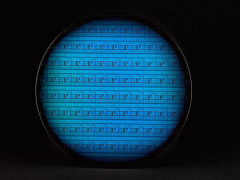
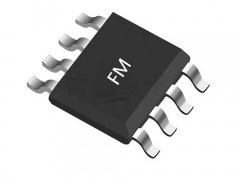
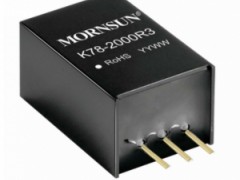
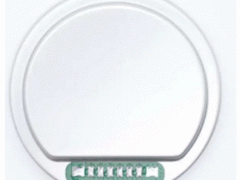
 客服微信
客服微信 查ic网订阅号
查ic网订阅号

